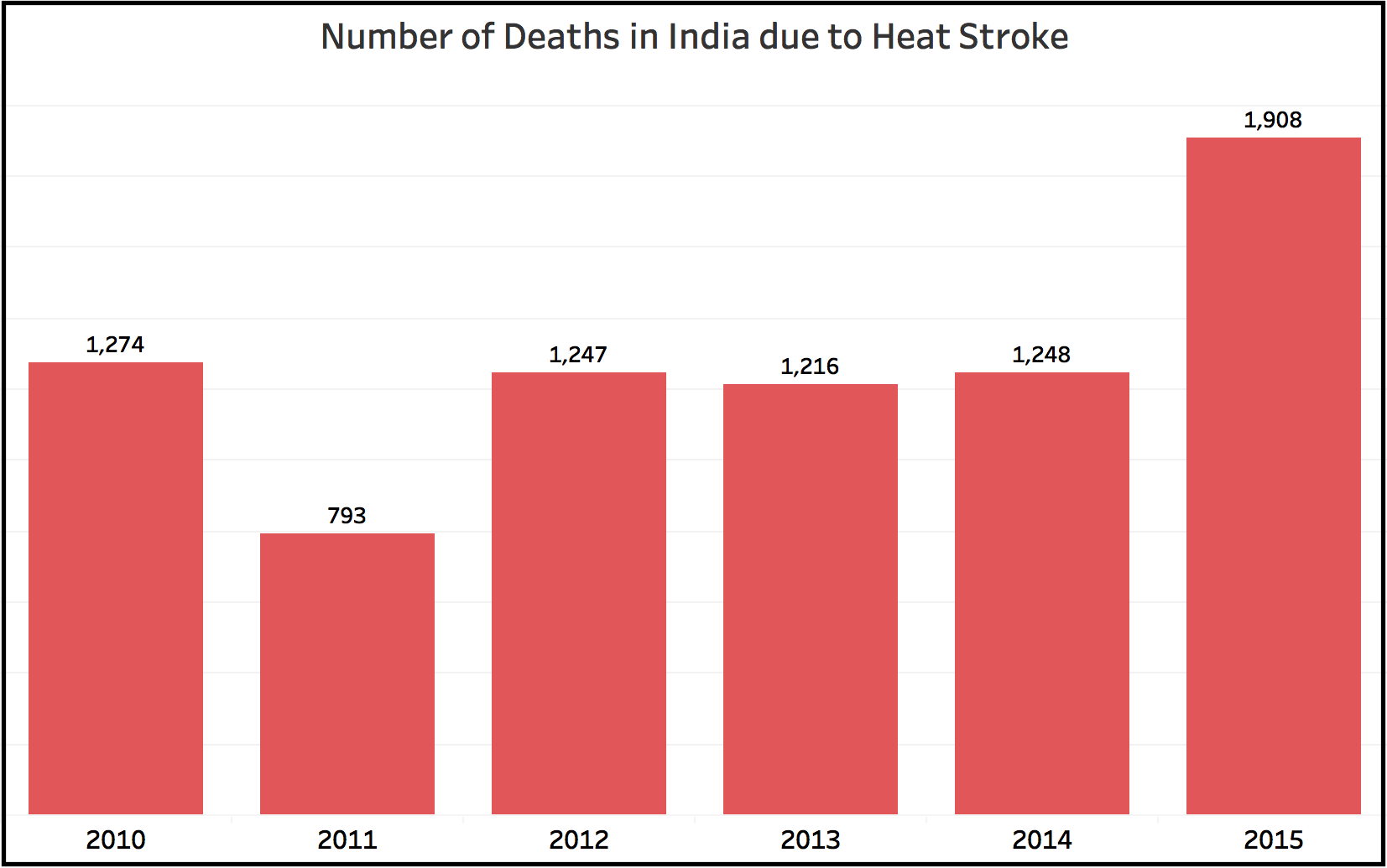[orc]Severe heat wave conditions are expected to prevail in many states during summer. The National Crime Records Bureau Data indicates that a total of 7686 people lost their lives due to Heat Stroke from 2010 to 2015. This is more than 3 deaths a day. Andhra Pradesh alone accounted for 1825 deaths, about 24% of the All India figure. But the data from the Ministry of Earth Sciences presents a completely different picture raising serious doubts about the reliability of NCRB data.
The season of extreme temperatures is approaching. Many people lose their lives each year because of the extreme heat wave conditions. The number of deaths due to Heat Stroke, as recorded by the National Crime Records Bureau (NCRB) between 2010 and 2015 is 7686.
More than 50% increase in the number of deaths in 2015
Between 2010 and 2015, a total of 7686 people lost their lives because of Heat Stroke, an average of more than 3 deaths per day. 1274 people lost their lives in 2010 while the number came down to 793 in 2011, a decrease of 38%. The year 2011 saw a sudden dip in the number of deaths only to increase the next year to 1247. Both 2013 & 2014 witnessed about 1200 deaths each year. In the year 2015, the number of deaths increased to 1908, an increase of more than 50% compared to 2014.
 More than 80% of the victims are Male
More than 80% of the victims are Male
Out of 7686 deaths from 2010 to 2015, 6198 victims are male while 1487 victims are female. In other words, about 81% of the victims in these six years are male while the rest of the 19% are female. This breakup was more or less same in each of these years. The number of male victims was more than 1000 in five of these six years.
 Heat Stroke Deaths accounted for 20% of deaths due to Natural causes in 2015
Heat Stroke Deaths accounted for 20% of deaths due to Natural causes in 2015
The NCRB compiles deaths due to various natural causes like Avalanche, Cyclone, Cold, Tsunami, Earthquake, Floods, and Landslides etc. Deaths due to Heat Stroke accounted for close to 5% of all the deaths due to the natural causes between 2010 and 2014. But in the year 2015, the number of deaths due to natural causes reduced to half of what it was in 2014, largely on account on the decrease in the number of deaths due to ‘other natural causes’. On the other hand, the number of deaths due to heat stroke increased by more than 50% in 2015. Hence the proportion of heat stroke deaths out of deaths due to natural causes increased to 18% in 2015.
| Year | Number of Deaths to Heat Stroke | Number of Deaths due to Natural Causes |
|---|---|---|
| 2010 | 1274 | 25066 |
| 2011 | 793 | 23960 |
| 2012 | 1247 | 22960 |
| 2013 | 1216 | 22759 |
| 2014 | 1248 | 20201 |
| 2015 | 1908 | 10510 |
1 out of every 5 deaths occurred in Andhra Pradesh
Out of the 7686 deaths in these 6 years, 1825 deaths occurred in Andhra Pradesh alone. This is 1 out of every 5 deaths or 24% of all the deaths. Uttar Pradesh accounted for 1099 deaths in these six years and Punjab was next in the list of victims with 867 deaths followed by Bihar was with 649 deaths. Odisha was the only other state that accounted for more than 500 deaths during this period. Tamil Nadu recorded only 19 deaths in these 6 years. In fact, Tamil Nadu did not record a single death in the four year period between 2012 and 2015. Is the NCRB data reliable?
Is the NCRB data reliable?
The NCRB compiles reports based on data supplied by the State Crime Records Bureaux (SCRBx) which in turn gets data from the District Crime Records Bureaux (DCRBx). The NCRB data pertains to deaths that are recorded. At the same time, there could be other deaths due to Heat Stroke that go unreported.
The case of Andhra Pradesh is intriguing. In response to a question in the Lok Sabha in March 2017, the government reported that there were 1422 deaths due to heat wave conditions in Andhra Pradesh in 2015. But the NCRB data for 2015 reports only 654 deaths in Andhra Pradesh. Even the total number of deaths across the country is at variance in these reports.
The lower number of victims in states like Tamil Nadu also throws up questions about the reliability of NCRB data.The heat wave conditions (temperatures) in Tamil Nadu were not very different from the neighbouring Andhra Pradesh. The state of Tamil Nadu must be doing a stellar job of tackling the heat wave conditions compared to Andhra Pradesh, to not report a single victim in four years. But that does not seem to be the case.
Such contradiction in data from two different government entities raises questions about the reliability of NCRB reports.
Featured image: NOAA Climate.gov map by Fiona Martin, based on interpolated weather station data provided by the India Meterological Department.



2 Comments
Pingback: Oolta.in | 1 Out Of Every 5 Heat Stroke Deaths In India Occurs In Andhra Pradesh, Know The Details
Pingback: 10 Best Air Coolers in India - Reviews, Buying Guide & Comparison (2019) - Mr10.in